Managing Heat and Light Through Exterior Shading Systems
The advantages of solar control from the outside
![]() Continuing Education
Continuing Education
Use the following learning objectives to focus your study while reading this month’s Continuing Education article.
Learning Objectives - After reading this article, you will be able to:
- Discuss the key aims of solar control and how they influence energy costs of a building.
- Explain the reasons why exterior shading systems are more effective than interior shades in controlling unwanted heat gain and thus improving energy costs and occupant productivity and well-being.
- Enumerate the factors that influence the choice of a shading system that will add to a building’s sustainability profile and user comfort.
- Explain the benefits of using exterior venetian blinds to control solar gain through vertical glazing, and the benefits of using the rack arm system to control solar gain through skylights and sloped glazing.
Who hasn't enjoyed the feel of the sun streaming through a window, bringing a warm glow to the building inside. Unmitigated sunlight, however, comes with problems of its own, notably unwanted heat and glare, a situation that, particularly in large commercial structures, requires a well-thought-out solution. While American designers and architects generally opt for interior devices to shade rooms from the sun, for years their European counterparts have embraced another method: exterior shading systems. An aesthetic solution that can add up to superior energy savings, exterior shading systems reflect and absorb solar energy outside the building, before it penetrates the window, which is a key advantage over interior shading devices. This article will cover the dynamics of solar control as well as options in exterior shading systems and how they affect a building in terms of energy costs, user comfort, and overall sustainability profile.
Solar Control—What Is It?
The term solar control is often used, but its meaning is not always fully understood. Solar control is about managing the energy from the sun. The sun provides both heat and light and the aim of a solar control system is to maximize the use of natural daylight in a building while ensuring that problems do not occur as a result of excessive heat gain and glare. This sounds like a fairly straightforward exercise; getting a shading system to meet these requirements is not that easy to achieve. In the end, a combination of systems might be needed to address all three areas of concern.
It may seem obvious, but when questioned, most people cannot explain how energy from the sun turns into heat. This is a very important issue to grasp in order to understand why it makes sense to use an exterior shading system rather than an interior one.
Sunlight is made up of energy with a range of different wave lengths covering what is known as the solar spectrum. The solar spectrum can be split into three main sections—ultra violet, visible light, and infrared. All of these sections have a short wavelength. When sunlight reaches the earth and hits a surface, however, it is either absorbed or reflected. The surface might be the ground, vegetation, water, or a person. The absorbed part of the solar energy is emitted as long-wave energy which produces heat.

Image courtesy of Draper, Inc.
Exterior shading systems offer enhanced user comfort and reduced energy costs, contributing to greater overall project sustainability.
To get an understanding of this, consider the example of a car on a bright, sunny winter day. It is cold outside, but the inside of the car is very hot, almost like an oven. This is because the solar energy comes through the windshield of the vehicle, as glass is almost transparent to short-wave energy. The solar energy is absorbed by the surfaces inside the car (seats, dashboard etc.) and is then emitted as heat. Long-wave energy doesn't pass through glass easily and, as a result, the hot air is trapped inside the car. To deal with this issue, people sometimes put highly reflective silvered screens onto the windshield of cars on sunny days, as the screen will reflect the solar energy back out of the windshield before it is absorbed and converted into heat.
Heat Gain in Interior Systems
Let's now take this concept and apply it to an interior shading system. Effectively, it is the same situation as with the example of the car. Any solar energy that gets into the building will be absorbed and will turn into heat. An interior shading system will, to a certain extent, act like the silvered screen in the windshield of a car; it will reflect solar energy back through the glazing to the outside. Unlike a car screen, however, the shading system is not completely opaque; it is designed to allow some light into the building and to afford views to the exterior. It will therefore reflect some of the solar energy but some will be absorbed by the system and some will pass through it.
If the shading system has a light color, the amount of energy reflected will be increased and the amount of energy absorbed will be reduced. Dark surfaces will absorb more of the solar energy. A reflective surface facing the glazing is therefore important to improve the solar performance of the shading system. To try and address this, some shade fabrics, for example, have an aluminized finish applied to the side that faces the glazing to improve the amount of reflectivity. The solar energy that has not been reflected back through the glazing will either be absorbed by the shading system or will be transmitted through it. The absorbed energy will then be radiated into the building while any that is transmitted through the shading system will be absorbed by surfaces inside the building and will also be radiated as heat.
As with the example of the car, this energy is trapped inside the building and not much of it escapes to the exterior, particularly if a low E finish is applied to the glazing. The inside of the building and the occupants will heat up.

Photos courtesy of Draper, Inc.
An effective solar control system is one that maximizes the use of natural daylight while addressing the problems of glare and excessive heat gain.
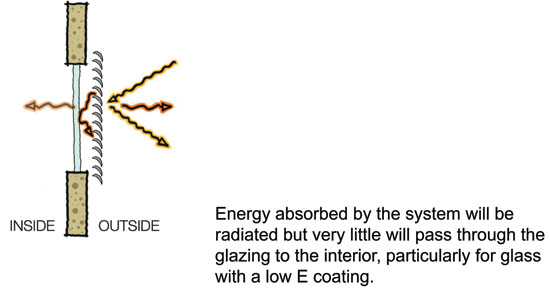
Image courtesy of Draper, Inc.
Heat Gain in Exterior Systems
An exterior shading system broadly performs like an interior one in as much as it will reflect some solar energy, will absorb some, and will allow some to pass through it and into the interior of the building. Very little of the solar energy absorbed by the shading device, however, will pass through the glazing to the interior—most of it will be dissipated outside. This is particularly the case when low E coatings are applied to the glass. These coatings will primarily prevent long-wave radiation (heat) from passing through the glazing. Solar control low E coatings, however, can also block some short-wave radiation. If the shading is on the interior, some of the reflected solar energy can be trapped inside the building and will eventually convert into heat. If the shading is on the exterior, however, all of the reflected energy remains outside. As a result of these factors, exterior shading systems are therefore much more effective than interior ones.
Solar Heat Gain Coefficients
The increased performance of an exterior shading system can be clearly seen from the accompanying graph of solar heat gain coefficients (see the online version of this course). The solar heat gain coefficient is the fraction of the incident solar radiation admitted through a window assembly, including that which is directly transmitted and that which is absorbed and reradiated inwards. The lower a window assembly's solar heat gain coefficient, the less solar heat it transmits.
If there is an opening with no glazing, all of the solar energy passes straight through it and the solar heat gain coefficient is therefore 1.00. Installing glazing will provide some solar control. Current glazing technology means that a low solar heat gain coefficient is achievable although this often results in a significant reduction in light transmittance. Performance will be improved by the introduction of an interior shade but, as shown in the graph of solar heat gain coefficients, the impact is relatively limited. To achieve effective shading performance without the need to go to very high-performing glazing it is therefore necessary to move the systems to the exterior—with an exterior venetian blind, for example, more than 90 percent of the heat gain can be blocked before it enters the building.
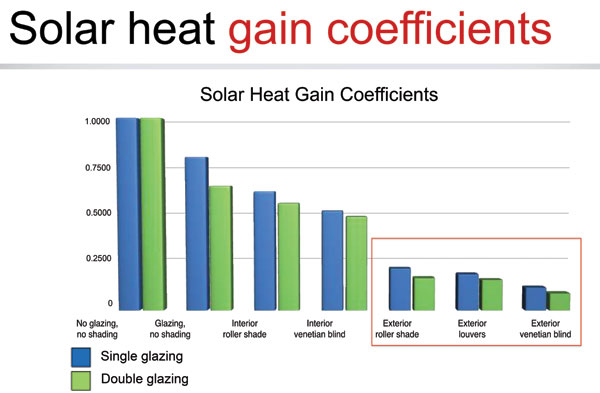
Image courtesy of Draper, Inc.
Three Main Components of Solar Control
As previously mentioned, solar control involves three factors: daylighting, glare, and heat gain.
Daylighting
Designers have given much attention to daylighting in recent years. Yet it is important to fully examine the concept in order to maximize its benefits and decrease potential problems.
As Gregg Ander, FAIA, of Southern California Edison, puts it, “Daylighting is the controlled admission of natural light into a space through windows to reduce or eliminate electric lighting. By providing a direct link to the dynamic and perpetually evolving patterns of outdoor illumination, daylighting helps create a visually stimulating and productive environment for building occupants, while reducing as much as one-third of total building energy costs.”
A few phrases in this definition warrant emphasis:
▶ Controlled daylight. Letting as much light into the building as possible is not an effective daylighting practice.
▶ Dynamic illumination. People like variable daylight rather than consistent artificial light. Changing light levels give a feeling of contact with what is happening outside, irrespective of view, and can contribute towards improved productivity. To manage daylight and control glare, the shading system needs to be adjustable to take account of the sun conditions.
▶ Reduction of energy costs. Controlling daylight effectively can reduce the requirements for artificial lighting, giving significant cost savings.
Shading devices are particularly important in controlling the amount and usability of daylight in the building. This can be achieved with an interior shading system but also with an exterior one.
Glare
The amount of light that comes into the space should be sufficient to meet the needs of the people in the building but not significantly more as this can cause problems from glare. Glare has been defined by lighting experts as “the result of excessive contrasts of luminance in the field of view. The effect may vary from mild discomfort to an actual impairment of the ability to see. When the ability to see is impaired this is called disability glare. Discomfort glare is associated more with interiors; it refers to the discomfort or distraction caused by bright windows or luminaires.”
It is this discomfort glare is that is most concerning. As highlighted in the quote, one source of this glare is bright windows. By using shading systems to modulate light at the window, contrast between the window and the immediate surroundings where someone is working can be reduced, eliminating or significantly reducing the impact of glare.
Depending on the exterior system used, this goal might be achievable. The use of operable shading systems, particularly in conjunction with automated controls, can be very effective in managing daylight and glare. With certain systems, however, interior shading systems will also be required to manage light and glare. This may be the case, for example, with an exterior venetian blind. It is possible that the system will be left in the retracted position during the winter months to allow free solar gain into the building, reducing heating requirements. In these circumstances, an interior system will be required to control daylight and glare.
Exterior Shading Systems—The Benefits
If an external shading system significantly reduces the level of solar energy entering the building and the amount of heat gain that occurs as a result, it follows that the use of such a system will also reduce the building's cooling requirements. As a result, the size of the HVAC system can be reduced, providing up front savings to offset the cost of the shading system. As the cost of energy increases, however, the ongoing savings from the reduced running costs of a smaller HVAC system can also be significant.
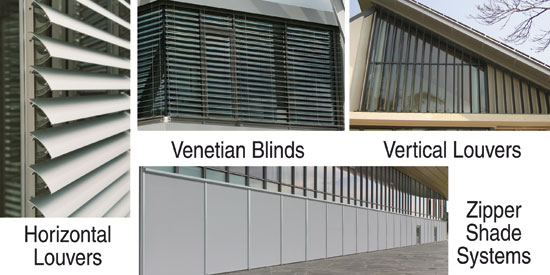
Image courtesy of Draper, Inc.
Exterior shading systems offer a host of benefits.
Other benefits of exterior shading systems include the following.
Increased sustainability. Consistent with concerns about energy use, greenhouse gases and global warming, using systems that reduce mechanical cooling requirements is an environmentally sound approach.
Conforming to regulations. Building codes around the world address the energy performance of the façade and many of them specifically refer to the use of exterior shading systems to assist in meeting code requirements.
Health and productivity. People like working in buildings where they have natural daylight and contact with the outside. Excessive heat gain, however, can cause discomfort for people in the building, particularly if they work adjacent to the glazing. Exterior shading devices can therefore contribute to a better working environment. Many studies have been undertaken and the results are all very similar: natural light improves peoples' mood and general well being and, perhaps most important to building and company owners, natural light increases their productivity, while reducing the number of sick days.
Better use of computer equipment. The almost universal use of computer screens in offices means that effective control of light is important. Computer usage also, however, generates significant heat and in most office environments triggers a substantial cooling requirement throughout the year. Reducing cooling needs by controlling solar gain is therefore a sensible approach to take in these situations.
LEED certification. LEED credits are available for optimizing energy performance, thermal comfort, daylighting, and quality views. The use of exterior shading systems can potentially assist in obtaining credits in all of these areas.
Options in Exterior Shading Systems
There are many different exterior shading systems available today. Exterior shading systems can be fixed or operable. Operable systems can allow the louver angle to be adjusted or they can be fully retractable as is the case with exterior venetian blinds and roller shades.
Not all the systems, however, will provide the same level of solar control. Fixed exterior systems such as brise soleil systems and fixed louvers are purely designed for heat control. While they may provide some light control, this is not their intended function. Operable louvers can be rotated to provide an increased level of solar control, which means they will also provide some daylight control, though that is not their main function either. The other systems listed in the accompanying chart provide much higher levels of light and glare control as well as the control of heat gain. As will be examined in more depth later, the rack arm system, for example, is often used in museums and art galleries where light control is critical.
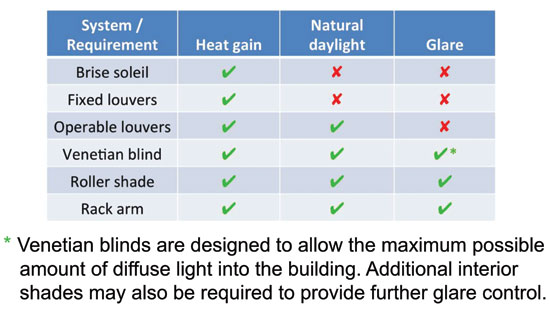
Chart courtesy of Draper, Inc.
Choosing the Correct Exterior Shading
With a number of different shading options available, it is important to get an understanding of specific project requirements to determine the most appropriate system. The following factors should be considered.
The Building Location and Orientation of the Glazing
The shading requirements for east, south, and west facades vary because of the different sun angles that must be addressed.
Geographical Location
Just as important as building and glazing orientation is the actual geographical location of the building. In Miami, for example, the sun is almost vertical in the sky at midday on June 21 when the peak sun angle is just over 86 degrees. Even in winter, the sun angle in Miami is almost as high as the peak summer sun angle in Helsinki, Finland. In Miami, therefore, relatively short projections can provide effective shading, particularly on the south elevation. In places such as Helsinki, however, fixed projections will not be very effective and a much more adjustable system will be required to deal with the varying conditions and low sun angles. In summer in Helsinki, the sun sets almost due north; in the winter, however, it doesn't set very far to the west. Retractable shading systems are therefore appropriate for the west elevation and it may also be necessary to provide some shading on north west (or even north) elevations to control glare.
In addition to latitude and longitude, it's also important to understand the context of the building. In an urban environment, overshadowing from surrounding buildings could have a significant impact and may mean that certain parts of the building that should be exposed to the sun are, in fact, permanently shaded. The effect of the building being close to water might also need to be considered. For example, light reflected from water can cause glare issues that can be effectively addressed by a fabric system but not by a venetian blind or horizontal louvers, which will allow reflected light to pass through the system to the interior.
Climatic Conditions
All shading systems have to be suitable for the prevailing climatic conditions. Fixed systems need to withstand maximum wind, snow and ice loads whereas operable systems such as exterior roller shades and venetian blinds need to be retracted in adverse weather conditions. Depending on the wind and ice conditions, however, certain operable systems may not be the best choice; if shades need to be operated frequently, a better choice might be a fixed system or one that is adjustable but not retractable.
Building Heating and Cooling Requirements
A building's heating and cooling requirements can also influence the choice of shading system. Exterior shading systems don't discriminate between different times of the year—if they are installed in front of the glazing, they will reduce the amount of heat gain entering the building. If a building has heating requirements in the winter months, exterior venetian blinds or roller shades may be retracted and left in this position during this period to allow sun and the associated heat gain into the building. This is a free source of heat and will reduce energy requirements and costs. If this is the case, however, interior glare control systems, such as roller shades, will almost certainly be required.
Building Aesthetics
With certain building designs, large scale louvers may be used to provide a strong aesthetic look. In other situations, shading systems might be on the interior or in a double façade to allow the building to have a clean, glazed appearance. Projecting systems, like brise soleil systems, are often used to shade south elevations—they don't work well with low sun angles on the east and west elevations but may be still used to provide a consistent look to the building. In this case, however, it's important that the client and the design team understand that the shading systems will not function very effectively and that a secondary interior system will almost certainly be required as well on these elevations.
Performance Requirements
Naturally, performance requirements must be considered and depending on the level of solar control required, one system may be more appropriate than another. The shading systems are just one item that will impact the building and façade performance. Other factors will include the extent of the glazing by façade, the type of glass selected and the wall construction. The required performance contribution from the shading will therefore vary depending on the design decisions that have been taken. In certain situations, the shading system will only need to make a relatively small contribution to the overall performance and limited usage of fixed exterior louvers might be appropriate. In other situations, an adjustable system that can provide effective solar control throughout the year may be required.
Specific Options—Exterior Venetian Blinds and the Rack Arm System
The final sections of this article will look in more detail at two of the available exterior shading systems: exterior venetian blinds and the rack arm system.
Venetian Blinds
Exterior venetian blinds operate in a similar way to interior ones in as much as they can be raised and lowered. The slats can also be tilted, which provides an additional level of controllability compared to a roller shade system. It also means that the systems can be used on any façade as the slats can be adjusted to provide solar control whatever the sun angle. As highlighted earlier, this system has a solar heat gain coefficient of less than 0.10 and can therefore prevent more than 90 percent of the solar energy from passing through the glazing and being converted into heat. Venetian blind slats are available in a variety of sizes from two to six inches and are of a larger size than the systems that have historically been used in the US.

Image courtesy of Draper, Inc.
The accompanying chart, which was produced by software, shows the sun exposure of west facing glazing on a building in Indianapolis. The vertical axis of each graph shows the time of the day and the horizontal one shows the months of the year. Areas on the graph that are blue indicate no sun on the glazing; areas that are yellow indicate full sun.
As expected with a west facing elevation, the sun is on the glazing during the afternoon and there is more sun exposure in the summer than in the winter. As can be seen, a brise soleil system is not very effective, even with a relatively large projection, as the lower sun angles pass below the shading system and onto the glass. The graphs on the right hand side of the illustration show a venetian blind with the slats horizontal and then tilted up to 45 degrees. The improving performance is very noticeable and by tilting the slats further to the closed position—which is in fact a rotation through approximately 70 degrees—it is possible to deal with the late afternoon / early evening when the sun is low in the sky.
There are various slat options as well as perforation alternatives. Slats can be fully perforated, highway perforated (where the central strip is left unperforated), half perforated, or solid. Perforated slats will allow a view through to the outside, even when the blinds are in the closed position. The blinds can, however, be horizontal or only partially tilted during most of the day, and are only generally closed during the early morning or late afternoon when the sun is low in the sky. In these cases, perforation can cause glare issues and, as a result, the need for perforation should be carefully considered. If the decision is made to go with perforated slats, it is preferable to use ones with a low openness factor. Perforated slats are also more expensive than a solid-slat system, as an additional production process is required.
Wind, Ice, and Durability Considerations
Although these systems, and particularly the slats, can appear lightweight they are in fact very durable and can withstand significant wind speeds of up to nearly 40 mph. In normal operation, the slats would be moved to the open position to allow an equalization of pressure on both sides of the blind at around 30 mph. They would fully retract at higher wind speeds. Consider the wind force as you put a hand out of the window of a car that is travelling at 30 mph. The wind override in an automatic system overrides all other controls to ensure that the blinds are not deployed when there is a risk of damage through strong winds.
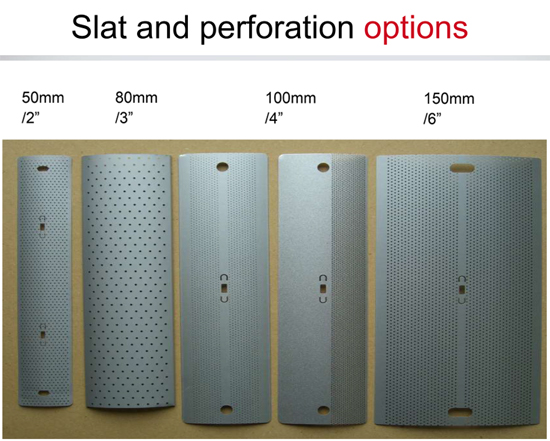
Image courtesy of Draper, Inc.
Exterior venetian blinds should be retracted into a pocket when they are not being used to protect them from the wind and, probably more importantly, from ice. For a head box to be effective, it must be water tight. If not, water can get onto the blind and freeze if the temperature subsequently fell below freezing. If it is bright and sunny the following day and the system is deployed, problems can arise if the system is iced up. Such was the case at a project in Iowa where the slats were dramatically bent. The flexible slats that are used with venetian blinds, however, are very durable and none of the slats needed to be replaced. This problem effectively demonstrated the durability of the system—it could have been avoided, however, if the head boxes had been properly constructed.
In another example, exterior venetian blinds on a project in Tempe, Arizona, were installed with the slats running between side 'C' profiles. They were also set about 8 feet away from the glazing, which meant that the systems were more affected by wind than would have been the case if they had been installed close to the glass. The slat area deflected under wind load, the slats came out of the channels and got caught at the top and bottom. Once again, the slats appeared to be bent and irreparably damaged but, in fact, were perfectly OK when the issue was resolved. To address this particular problem, the slat width was slightly reduced so that the slat edges were just inboard of the channels and not between them.
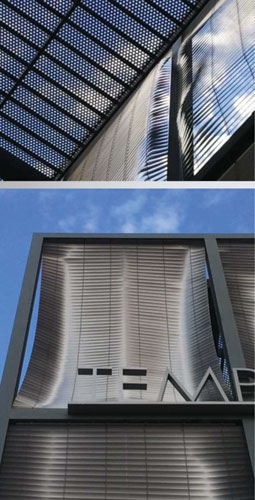
Photos courtesy of Progressive Commercial Interiors
The blinds in the images above were affected by strong winds but amazingly none of the slats were damaged.
Rack Arm System
The rack-arm system is a non-retractable louver system. It can effectively shade any type, shape or any orientation of glazing and provides very effective solar control. Further, the rack arm system can provide high levels of light exclusion (but not blackout), particularly if an interlocking slat is used.
Rack arms are installed to the glazing structure. Spacing is dependent on whether the installation is interior or exterior as well as on the slat size. Rack arms are connected by a drive shaft that in turn is connected to the operator. Slats are mounted onto the rack arms. It's important to note that the slats rotate between open and closed but the system, unlike a venetian blind, cannot be retracted.
The rack system has been developed for exterior use and, if designed and installed correctly, can withstand wind speeds in excess of 100mph. In exposed locations it is appropriate to use baffles to protect the slats around the edge of the system; it is also recommended that a wind control feature is used and that the slats are moved to the open position in strong winds to allow an equalization of pressure. This reduces slat movement and makes the system much more stable.
The rack arm system has a large number of small rotating parts which makes ice a potential issue, particularly with motorized systems. Projects therefore need to be carefully considered and, in some locations, an interior installation is probably the only realistic option. In many parts of the U.S., however, the system is certainly viable as an exterior system.
Another advantage of the rack system is that it possesses the flexibility to deal with various shapes of glazing. Not only can it be installed on vertical, sloped and horizontal glazing, it can also be designed to shade triangular and circular openings, etc. No other shading system is able to effectively deal with these types of requirements. Further, the system has been used in museums and galleries throughout the world where the need for precise light control is particularly important.
Shading a skylight. Rack arm systems are primarily used to shade skylights. Consider the accompanying graphs that were generated using software and show the incident solar radiation by façade orientation.

Image courtesy of Draper, Inc.
Contrary to general expectations, the radiation on the south elevation is least significant in the summer months. This is because of the high sun angles and the oblique angle of the sun to the glazing. The incident radiation on the roof glazing, however, is much greater than is the case with any of the vertical façades during the period from March to September. The amount of solar radiation as shown in graphical format clearly shows this and highlights why the shading of horizontal and inclined glazing should be considered during the design phase of a building.

Photo courtesy of Progressive Commercial Interiors
For skylight shading at a Paris office, an exterior rack arm system provides light and solar control while enabling the shading of triangular glazing elements.
For skylight shading at an office in Paris, an exterior rack arm system provides very effective light and solar control and also enables the triangular glazing elements to be shaded. The Paris climate means that using the system on the exterior is possible, and that weather-related risks are not a significant issue. By installing the system on the exterior, very good solar control is achieved, reducing heat gain inside the office during the summer months. The adjustability of the louver angle means that direct sun penetration is prevented, ensuring high levels of natural daylight, without the problems of glare, for people working in the office below the skylight.
Control Systems for Exterior Shading
Operable exterior shading systems will require a control system. As a minimum they will need to be protected against wind and systems such as venetian blinds and roller shades will, as already highlighted, need to be retracted if the wind speed is too high. Given that exterior systems are designed to control heat gain into the building, they will generally be automated and will respond to the sun conditions. This means that systems will automatically deploy and retract and the slats of venetian blind systems will move between different tilt angles to prevent direct sun penetration. Because this is the case, it's important that the building users understand the function of the systems and are given initial training or a briefing about how the systems work and how they help control the building environment and create good working conditions. User override of the systems also needs to be considered at an early stage. Control systems will generally allow varying degrees of user override and will also capture systems back into automatic after a period of time to ensure that solar control of the building is maintained.
Exterior Shades Manage Heat and Light
When it comes to efficiently managing heat and glare with maximum effective daylighting potential, exterior shading systems offer unique benefits. Through enhanced user comfort, decreased energy costs, and a significant addition to overall project sustainability, exterior systems are becoming recognized as a desirable option in the toolbox of U.S. architects, just as they have been a staple for decades in European design.
Draper, Inc. is a Spiceland, Indiana-based manufacturer of window coverings, audio visual equipment, and gymnasium equipment. Draper has more than 110 years of experience in the window coverings industry. www.draperinc.com |



